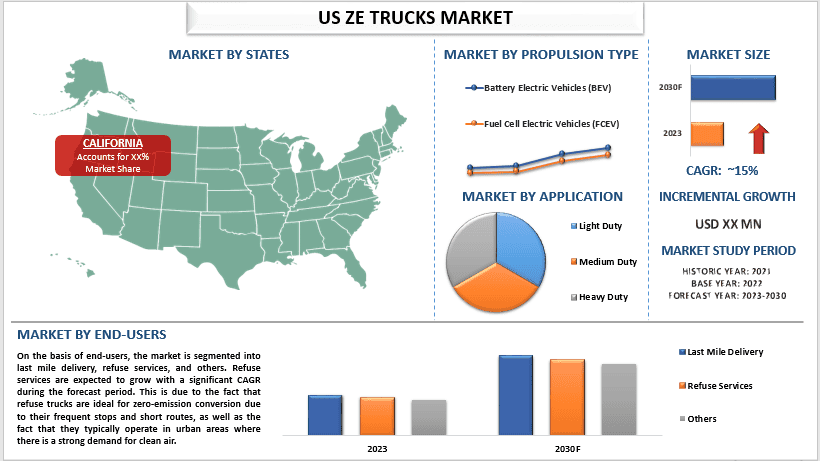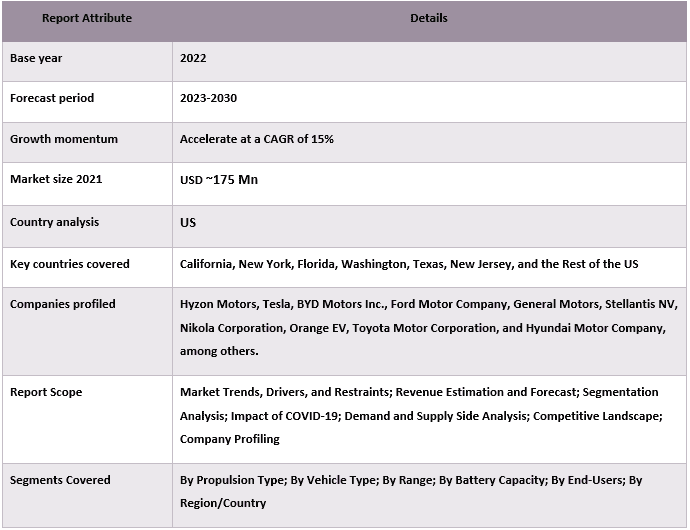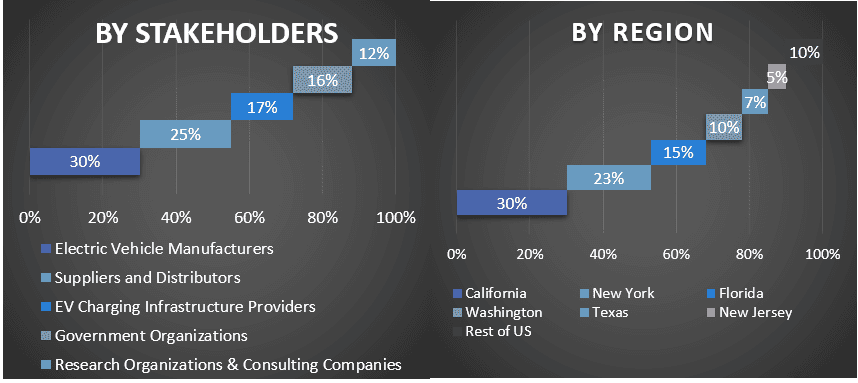- Home
- About Us
- Industry
- Services
- Reading
- Contact Us
US ZE Trucks Market : Current Analysis and Forecast (2022-2030)
Emphasis on Propulsion Type (Battery Electric Vehicles (BEV) and Fuel Cell Electric Vehicles (FCEV)); Vehicle Type (Light Duty, Medium Duty, and Heavy Duty]; Range (Less than 50 kWh, 50-250 kWh, and More Than 250kWh); End-Users (Last Mile Delivery, Refuse Services, and Others); and States

The US ZE trucks market is expected to grow at a strong CAGR of around 15% during the forecast period as governments around the country implement policies to incentivize the purchase of EVs, including tax credits and subsidies. This has led to a surge in demand for EVs, which in turn is driving down the demand for EV Trucks. The growth of zero-emission electric trucks can be attributed to several factors such as the increasing concern for environmental sustainability and the need to reduce greenhouse gas emissions. Electric trucks produce zero tailpipe emissions, making them a cleaner alternative to traditional diesel trucks and helping to combat air pollution and climate change. The availability of government incentives and regulations promoting the adoption of electric vehicles has also played a significant role in driving the growth of electric trucks. As a result, the combination of environmental consciousness, technological advancements, government support, and economic benefits is driving the growth of zero-emission electric trucks in the transportation industry.
Some of the major players operating in the market include Hyzon Motors, Tesla, BYD Motors Inc., Ford Motor Company, General Motors, Stellantis NV, Nikola Corporation, Orange EV, Toyota Motor Corporation, and Hyundai Motor Company, among others. Several M&As along with partnerships have been undertaken by these players to facilitate customers with hi-tech and innovative products/technologies.
Insights Presented in the Report
“Amongst Propulsion Type, FCEV segment will grow at the fastest rate during the forecast period.”
Based on propulsion type, the market is bifurcated into BEV and FCEV. Amongst these, the FCEV segment will grow at the fastest rate during the forecast period. The growing concern about environmental sustainability and the need to reduce greenhouse gas emissions has prompted a shift towards cleaner transportation options. FCEV trucks offer a viable solution as they produce zero tailpipe emissions, thus contributing to improved air quality and reduced carbon footprint. Advancements in fuel cell technology have made FCEV trucks more efficient and practical for commercial use. Moreover, market key players are adopting strategic alliances, which is also a factor driving the growth of the market. For instance, in 2023, Hyundai pitched fuel cell trucks as the zero-emission replacement for diesel big rigs as it introduces a Class 8 version for the U.S. at the ACT Expo.
“Amongst battery capacity, 50-250 kWh is expected to hold the second highest market share during the forecast period.
Based on battery capacity, the market is segmented into less than 50kWh, 50-250kWh, and more than 250 kWh. Among these, 50-250kWh is expected to hold the second-highest market share during the forecast period. The growth of 50-250 kWh batteries in electric trucks can be attributed to factors such as extended range and improved efficiency, enhanced payload capacity, technological advancements in battery technology, and the development of charging infrastructure. These larger battery capacities allow electric trucks to travel longer distances, carry heavier loads, and operate more efficiently, making them increasingly viable for commercial applications. Additionally, advancements in battery technology have increased energy density, enabling manufacturers to incorporate larger batteries without significantly increasing vehicle weight. As charging infrastructure expands, the practicality of using electric trucks with bigger battery capacities is further supported.
“California holds the largest share of the US ZE trucks market in 2022.”
California has been a leader in promoting the adoption of zero-emission vehicles, including trucks. The state has set ambitious goals for reducing greenhouse gas emissions and has implemented a number of policies and incentives to encourage the adoption of zero-emission vehicles. For instance, California has set a goal of putting 1.5 million zero-emission vehicles on the road by 2025 and has implemented a number of policies to encourage the adoption of zero-emission vehicles, such as the Low Carbon Fuel Standard and the Zero Emission Vehicle Mandate. Additionally, California has a large number of businesses and industries that rely on commercial vehicles for transportation and logistics, which also drives demand for zero-emission trucks.
US ZE Trucks Market Report Coverage

Reasons to buy this report:
- The study includes market sizing and forecasting analysis validated by authenticated key industry experts.
- The report presents a quick review of overall industry performance at one glance.
- The report covers an in-depth analysis of prominent industry peers with a primary focus on key business financials, product portfolios, expansion strategies, and recent developments.
- Detailed examination of drivers, restraints, key trends, and opportunities prevailing in the industry.
- The study comprehensively covers the market across different segments.
- Deep dive regional level analysis of the industry.
Customization Options:
The US ZE trucks market can further be customized as per the requirement or any other market segment. Besides this, UMI understands that you may have your own business needs, hence feel free to contact us to get a report that completely suits your requirements.
Table of Content
Research Methodology for the US ZE Trucks Market Analysis (2023-2030)
Analyzing the historical market, estimating the current market, and forecasting the future market of the US ZE trucks market were the three major steps undertaken to create and analyze the adoption of trucks in major states. Exhaustive secondary research was conducted to collect the historical market numbers and estimate the current market size. Secondly, to validate these insights, numerous findings and assumptions were taken into consideration. Moreover, exhaustive primary interviews were also conducted, with industry experts across the value chain of the US ZE trucks market. Post assumption and validation of market numbers through primary interviews, we employed a top-down/bottom-up approach to forecasting the complete market size. Thereafter, market breakdown and data triangulation methods were adopted to estimate and analyze the market size of segments and sub-segments of the industry pertains to. Detailed methodology is explained below:
Analysis of Historical Market Size
Step 1: In-Depth Study of Secondary Sources:
Detail secondary study was conducted to obtain the historical market size of the US ZE trucks market through company internal sources such as annual reports & financial statements, performance presentations, press releases, etc., and external sources including journals, news & articles, government publications, competitor publications, sector reports, third-party database, and other credible publications.
Step 2: Market Segmentation:
After obtaining the historical market size of the US ZE trucks market, we conducted a detailed secondary analysis to gather historical market insights and share for different segments & sub-segments for major regions. Major segments are included in the report as propulsion type, vehicle type, range, battery capacity and end-users. Further country-level analyses were conducted to evaluate the overall adoption of testing models in that state.
Step 3: Factor Analysis:
After acquiring the historical market size of different segments and sub-segments, we conducted a detailed factor analysis to estimate the current market size of the US ZE trucks market. Further, we conducted factor analysis using dependent and independent variables such as propulsion type, vehicle type, range, battery capacity and end-users of the US ZE trucks market. A thorough analysis was conducted of demand and supply-side scenarios considering top partnerships, mergers and acquisitions, business expansion, and product launches in the US ZE trucks market sector across the globe.
Current Market Size Estimate & Forecast
Current Market Sizing: Based on actionable insights from the above 3 steps, we arrived at the current market size, key players in the US ZE trucks market, and market shares of the segments. All the required percentage shares split, and market breakdowns were determined using the above-mentioned secondary approach and were verified through primary interviews.
Estimation & Forecasting: For market estimation and forecast, weights were assigned to different factors including drivers & trends, restraints, and opportunities available for the stakeholders. After analyzing these factors, relevant forecasting techniques i.e., the top-down/bottom-up approach were applied to arrive at the market forecast for 2028 for different segments and sub-segments across the major markets. The research methodology adopted to estimate the market size encompasses:
- The industry’s market size, in terms of revenue (USD) and the adoption rate of the US ZE trucks market across the major markets domestically
- All percentage shares, splits, and breakdowns of market segments and sub-segments
- Key players in the US ZE trucks market in terms of products offered. Also, the growth strategies adopted by these players to compete in the fast-growing market.
Market Size and Share Validation
Primary Research: In-depth interviews were conducted with the Key Opinion Leaders (KOLs) including Top Level Executives (CXO/VPs, Sales Head, Marketing Head, Operational Head, Regional Head, Country Head, etc.) across major states. Primary research findings were then summarized, and statistical analysis was performed to prove the stated hypothesis. Inputs from primary research were consolidated with secondary findings, hence turning information into actionable insights.
Split of Primary Participants in Different Regions

Market Engineering
The data triangulation technique was employed to complete the overall market estimation and to arrive at precise statistical numbers for each segment and sub-segment of the US ZE trucks market data was split into several segments & sub-segments post studying various parameters and trends in the areas of the propulsion type, vehicle type, range, battery capacity, and end-users in the US ZE trucks market.
The main objective of the US ZE Trucks Market Study
The current & future market trends of the US ZE trucks market were pinpointed in the study. Investors can gain strategic insights to base their discretion for investments on the qualitative and quantitative analysis performed in the study. Current and future market trends determined the overall attractiveness of the market at a state level, providing a platform for the industrial participant to exploit the untapped market to benefit from a first-mover advantage. Other quantitative goals of the studies include:
- Analyze the current and forecast market size of the US ZE trucks market in terms of value (USD). Also, analyze the current and forecast market size of different segments and sub-segments.
- Segments in the study include areas of the propulsion type, vehicle type, range, battery capacity, and end-users.
- Define and analysis of the regulatory framework for the US ZE trucks
- Analyze the value chain involved with the presence of various intermediaries, along with analyzing customer and competitor behaviors of the industry.
- Analyze the current and forecast market size of the US ZE trucks market for the major states.
- Major states studied in the report include California, New York, Florida, Washington, Texas, New Jersey, and Rest of US
- Company profile of the US ZE trucks market and the growth strategies adopted by the market players to sustain in the fast-growing market.
- Deep dive regional level analysis of the industry
Related Reports
Customers who bought this item also bought










